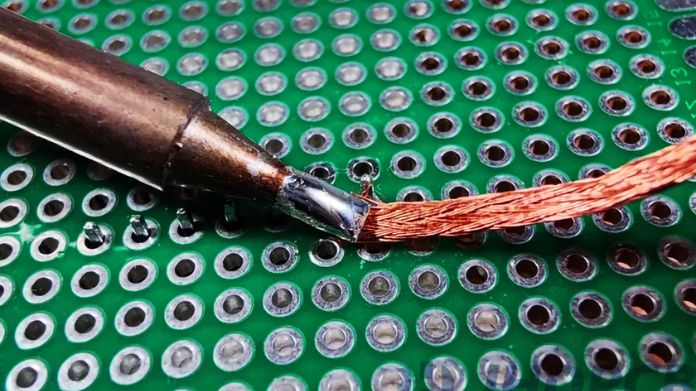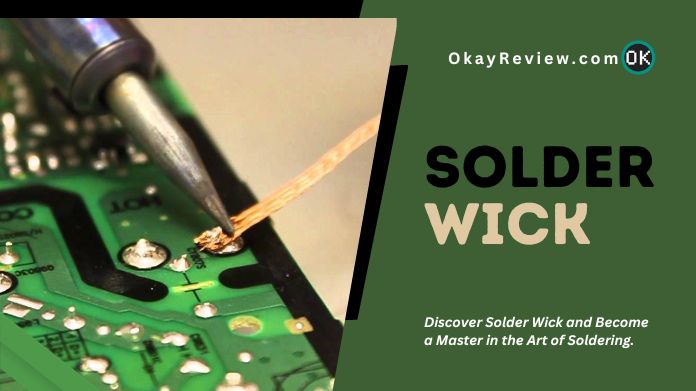Unlock the secrets of the soldering world with the solder wick, a game-changer in electronics!
Often overshadowed by flashier tools, the solder wick is the unsung hero, ensuring precision and perfection in every soldering task.
Curious about what makes the solder wick tick and how to wield it like a pro? Dive deep into this OkayReview guide, where we unravel its magic and share expert insights on mastering its use.
Whether you’re just starting or have years of soldering under your belt, this article is your key to unlocking the true potential of the solder wick.
Let the adventure begin!
Table of Contents
What is Solder Wick?
Solder wick, often called desoldering wick or solder braid, is a vital tool in the electronics realm. Comprising a thin, braided copper wire coated with flux, this tool specializes in the precise removal of solder from circuit board joints, connections, and components.
When heated over a solder joint, the solder wick springs into action. Its flux activates, drawing the molten solder into the braid through capillary action.
This process allows technicians and hobbyists to repair or rework electronic devices precisely and efficiently.
Whether rectifying a solder bridge, replacing a component, or cleaning up excess solder, the wick ensures a clean and professional finish.
If you’re looking for a convenient way to store your soldering tools, consider investing in high-quality tool bags. These can help you keep your tools organized and easily accessible.
Essentially, the solder wick is an indispensable ally in soldering tasks, providing accuracy and safety in every use.
How to Use Solder Wick?
Using a solder wick is a straightforward yet essential skill for anyone involved in electronics repair or rework. Begin by selecting the appropriate width of the solder wick suitable for the solder joint in question.
Place the solder wick directly over the solder you wish to remove. With your soldering iron heated to the right temperature, press the tip onto the wick, ensuring it matches the wick and the solder joint.
The solder will melt under the heat, and the flux-coated solder wick will swiftly soak it up using capillary action. After the solder gets absorbed into the wick, lift the soldering iron and let the joint cool down.
Trim the used portion of the solder wick, and you’re ready for the next desoldering task. With practice, using a solder wick becomes second nature, ensuring clean and efficient removal every time.
When to Use the Solder Wick?
 The solder wick proves invaluable in various soldering scenarios, acting as a rescuer when precision and cleanliness are paramount. Primarily, you’d reach for the solder wick when you need to replace a component on a circuit board.
The solder wick proves invaluable in various soldering scenarios, acting as a rescuer when precision and cleanliness are paramount. Primarily, you’d reach for the solder wick when you need to replace a component on a circuit board.
It aids in removing old solder, ensuring the component can be safely released. If you ever encounter a situation where two solder joints unintentionally connect, forming a bridge, the solder wick is your go-to tool to rectify the connection by removing the excess solder.
Additionally, during repair work or troubleshooting, the solder wick allows you to disassemble and rework circuits without causing damage to the components or the board.
Even for those meticulous tasks demanding utmost precision, like soldering surface-mount components, the solder wick ensures a pristine, professional finish. In essence, whenever solder removal or correction is on the agenda, the solder wick is the tool to trust.
Advantages of Using Solder Wick
- Precision: The solder wick offers unparalleled accuracy, ensuring that only the desired amount of solder is removed, leaving components and connections intact.
- Safety: With its gentle yet effective desoldering capabilities, the solder wick minimizes the risk of damage to delicate circuit boards and components.
- Efficiency: The solder wick’s design, combined with its flux coating, ensures rapid and thorough absorption of molten solder, speeding up the desoldering process.
- Versatility: Suitable for novices and seasoned professionals, the solder wick caters to a wide range of soldering needs, from simple repairs to intricate reworks.
- Clean Finish: Beyond its primary function, the solder wick also aids in achieving a neat soldering finish, enhancing the aesthetics and functionality of the project.
- Cost-Effective: Given its effectiveness and the potential savings from avoiding component replacements, the solder wick is a cost-efficient tool in the long run.
- Compact and Portable: The sleek design of the solder wick ensures effortless storage and portability, guaranteeing you’re always equipped with this vital tool when faced with soldering hurdles.
Tips for Effective Use of Solder Wick
Harnessing the full potential of the solder wick requires a blend of technique and knowledge. Here are some tips to ensure you’re using your solder wick to its utmost capability:
- Right Temperature: Before diving in, secure your soldering iron is heated to the optimal temperature for the type of solder you’re working with. A well-heated iron ensures the solder melts quickly, allowing the solder wick to do its job efficiently.
- Flux Matters: If using an unfluxed solder wick, consider applying some flux to the joints or pads you intend to desolder. This enhances the wick’s solder-absorbing capabilities.
- Positioning is Key: Lay the solder wick flat over the solder joint you aim to desolder. This maximizes the contact area, ensuring efficient solder absorption.
- Angle for Better Contact: When pressing the soldering iron onto the solder wick, angle the tip to contact both the wick and the solder joint. This improves thermal linkage and ensures the solder melts uniformly.
- Trim and Continue: After a section of the solder wick is saturated with solder, snip off the used portion. This keeps the wick fresh and ready for subsequent desoldering tasks.
- Avoid Prolonged Heat: Ensure you only keep the soldering iron on the wick briefly. Prolonged heat can damage components or lift the pads on the circuit board.
Conclusion
The solder wick, with its ability to remove solder with precision, stands as an indispensable tool in the electronics realm.
Whether you’re a hobbyist or a professional, understanding and effectively using a solder wick can elevate the quality of your soldering projects.
Frequently Answered Questions
Q. What is the Primary Purpose of a Solder Wick?
Ans. A solder wick is designed to precisely remove solder from joints, connections, and components on a circuit board by absorbing molten solder.
Q. How Does a Solder Wick Function?
Ans. It operates through capillary action. When heated over a solder joint, the flux on the wick activates, drawing the liquid solder into the braid.
Q. When is a Solder Wick Most Useful?
Ans. It’s invaluable for component removal, solder bridge rectification, cleaning up excess solder, repair work, and intricate soldering tasks.
Q. Can a Solder Wick Damage a Circuit Board?
Ans. If used correctly, a solder wick reduces the risk of damage to circuit boards and components. However, improper use can lead to potential damage.

